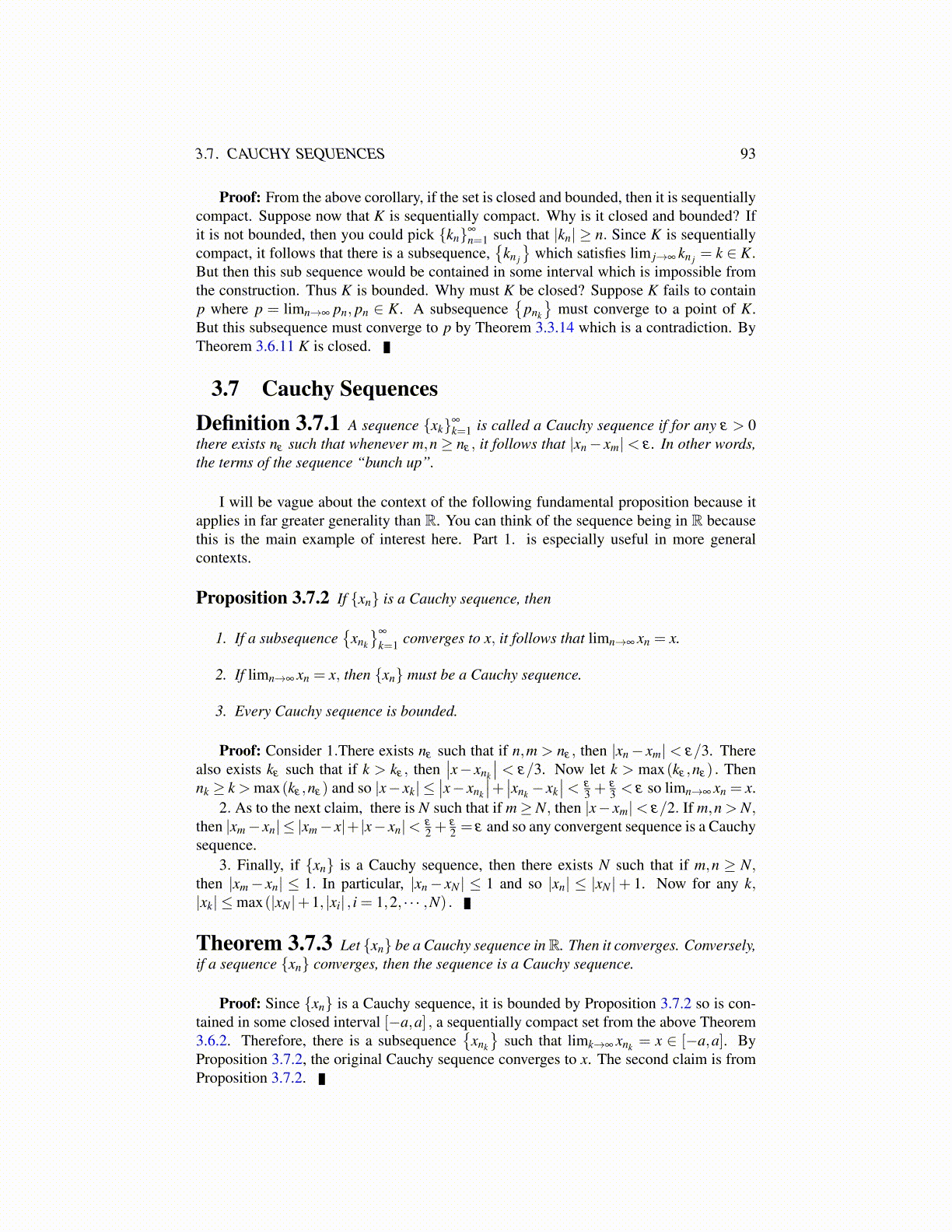
3.7. CAUCHY SEQUENCES 93
Proof: From the above corollary, if the set is closed and bounded, then it is sequentiallycompact. Suppose now that K is sequentially compact. Why is it closed and bounded? Ifit is not bounded, then you could pick {kn}∞
n=1 such that |kn| ≥ n. Since K is sequentiallycompact, it follows that there is a subsequence,
{kn j
}which satisfies lim j→∞ kn j = k ∈ K.
But then this sub sequence would be contained in some interval which is impossible fromthe construction. Thus K is bounded. Why must K be closed? Suppose K fails to containp where p = limn→∞ pn, pn ∈ K. A subsequence
{pnk
}must converge to a point of K.
But this subsequence must converge to p by Theorem 3.3.14 which is a contradiction. ByTheorem 3.6.11 K is closed.
3.7 Cauchy SequencesDefinition 3.7.1 A sequence {xk}∞
k=1 is called a Cauchy sequence if for any ε > 0there exists nε such that whenever m,n ≥ nε , it follows that |xn − xm|< ε . In other words,the terms of the sequence “bunch up”.
I will be vague about the context of the following fundamental proposition because itapplies in far greater generality than R. You can think of the sequence being in R becausethis is the main example of interest here. Part 1. is especially useful in more generalcontexts.
Proposition 3.7.2 If {xn} is a Cauchy sequence, then
1. If a subsequence{
xnk
}∞
k=1 converges to x, it follows that limn→∞ xn = x.
2. If limn→∞ xn = x, then {xn} must be a Cauchy sequence.
3. Every Cauchy sequence is bounded.
Proof: Consider 1.There exists nε such that if n,m > nε , then |xn − xm| < ε/3. Therealso exists kε such that if k > kε , then
∣∣x− xnk
∣∣ < ε/3. Now let k > max(kε ,nε) . Thennk ≥ k > max(kε ,nε) and so |x− xk| ≤
∣∣x− xnk
∣∣+ ∣∣xnk − xk∣∣< ε
3 +ε
3 < ε so limn→∞ xn = x.2. As to the next claim, there is N such that if m ≥ N, then |x− xm|< ε/2. If m,n > N,
then |xm − xn| ≤ |xm − x|+ |x− xn|< ε
2 +ε
2 = ε and so any convergent sequence is a Cauchysequence.
3. Finally, if {xn} is a Cauchy sequence, then there exists N such that if m,n ≥ N,then |xm − xn| ≤ 1. In particular, |xn − xN | ≤ 1 and so |xn| ≤ |xN |+ 1. Now for any k,|xk| ≤ max(|xN |+1, |xi| , i = 1,2, · · · ,N) .
Theorem 3.7.3 Let {xn} be a Cauchy sequence in R. Then it converges. Conversely,if a sequence {xn} converges, then the sequence is a Cauchy sequence.
Proof: Since {xn} is a Cauchy sequence, it is bounded by Proposition 3.7.2 so is con-tained in some closed interval [−a,a] , a sequentially compact set from the above Theorem3.6.2. Therefore, there is a subsequence
{xnk
}such that limk→∞ xnk = x ∈ [−a,a]. By
Proposition 3.7.2, the original Cauchy sequence converges to x. The second claim is fromProposition 3.7.2.